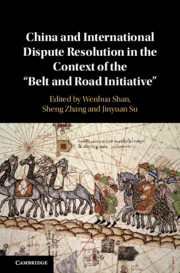Book contents
- China and International Dispute Resolution in the Context of the ‘Belt and Road Initiative’
- China and International Dispute Resolution in the Context of the ‘Belt and Road Initiative’
- Copyright page
- Contents
- Figures
- Tables
- Contributors
- Abbreviations
- Introduction
- Part I China, BRI and International Dispute Resolution
- Part II China, BRI and International Trade Dispute Resolution
- Part III China, BRI and Investment Dispute Resolution
- Part IV China, BRI and Resolution of Maritime Disputes
- Index
Introduction
Published online by Cambridge University Press: 03 March 2021
- China and International Dispute Resolution in the Context of the ‘Belt and Road Initiative’
- China and International Dispute Resolution in the Context of the ‘Belt and Road Initiative’
- Copyright page
- Contents
- Figures
- Tables
- Contributors
- Abbreviations
- Introduction
- Part I China, BRI and International Dispute Resolution
- Part II China, BRI and International Trade Dispute Resolution
- Part III China, BRI and Investment Dispute Resolution
- Part IV China, BRI and Resolution of Maritime Disputes
- Index
Summary
It discribles the background and motivations of this edited book and presents a summary of each chapter.
Keywords
- Type
- Chapter
- Information
- China and International Dispute Resolution in the Context of the ‘Belt and Road Initiative’ , pp. 1 - 8Publisher: Cambridge University PressPrint publication year: 2021
- 1
- Cited by



